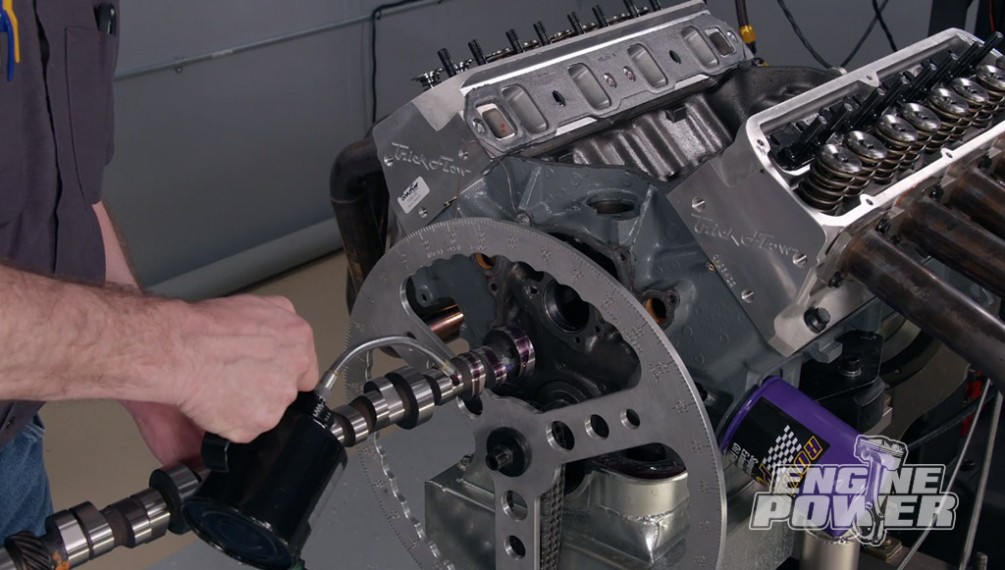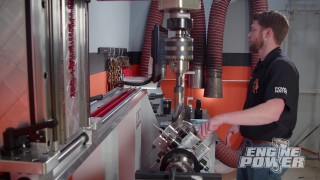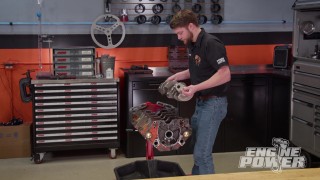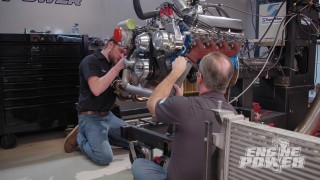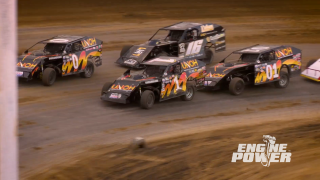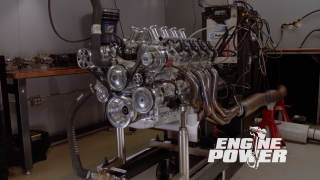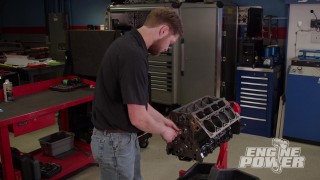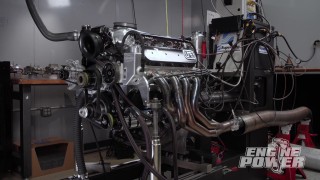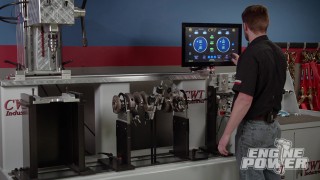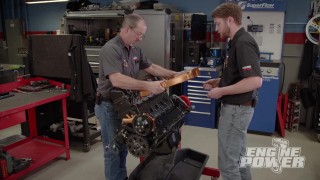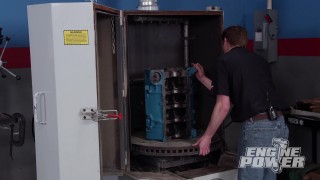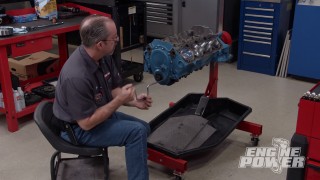Engine Power Featured Projects
Engine Power Builds
Want more content like this?
Join the PowerNation Email NewsletterParts Used In This Episode
ARP
Bolts & Fasteners
Edelbrock
Edelbrock Musi 24-Degree Cylinder Head
Edelbrock
Manifold Victor 24
Matco Tools
MATCO Tools are the Official Tool Supplier to PowerNation
Quick Fuel Technology Inc.
Quick Fuel 950CFM Carburetor
The Industrial Depot
Tools, Hardware, Shop Supplies
Trend Performance
Push Rods
Episode Transcript
(Mike)>> You're watching Powernation!
(Pat)>> There's no replacement for displacement. Forget stock, we're stroking some of our favorite builds with power tips and techniques. [ MUSIC ]
(Pat)>> Today we will revisit some of our stroker builds, and we love them because we get to show you all of the tech associated with increasing displacement, and one of our favorites was Old Gray Mare here.
(Mike)>> In the 351 cubic inch version this engine pumped out 448 horsepower and 423 pound feet of torque. With the increased stroke, a nice hone job, and a gain of 57 cubic inches our new version we dubbed Old Gray Mare increased the power and torque numbers to 522 on the horsepower side and 530 pound feet of torque.
(Pat)>> Now currently we are running a dual plane intake manifold, and with this air stack on that has an air turbine that measures air flow and this line in the back that measures manifold vacuum we can tell by our dyno data that we have some sort of air restriction. Now we know this because the carburetor will flow up to 950 c-f-m but the air turbine is telling us only about 680 c-f-m is going by it. Now couple that with the 1.7 inches of manifold vacuum, in this case it looks like our intake is the air restriction.
(Mike)>> With that being said this engine has more potential and we have the parts to show it. Now we will be swapping the hydraulic roller cam shaft out for a solid roller with a more aggressive profile, but first let's see what potential this engine has by increasing the air flow with a single plane manifold. The manifold going on is a Trick Flow R-series single plane we picked up from Summit Racing. This manifold has a larger volume and larger cross sectional areas in the runners. A straight path for the air/fuel mix to enter the cylinders creates a higher velocity for more efficient cylinder filling at all r-p-m's.
(Pat)>> What do you think?
(Mike)>> Let her rip tater chip.
(Pat)>> Just make a bang on it. [ engine revving ]
(Pat)>> That was pretty mean right there.
(Mike)>> That was really mean. A 66, a 66 and a 31 on torque.
(Pat)>> That is nice, nice, nice! Let's add a little r-p-m to it. I'm gonna add 500 to it.
(Mike)>> Remember we still have to do a cam swap in this thing. [ engine revving ]
(Pat)>> It carries power well.
(Mike)>> It carries it real well. A 71, yes, yes, yes!
(Pat)>> 530 for torque.
(Mike)>> In that 500 additional r-p-m it fell off to 496.
(Pat)>> Know what that's a function of? I can already tell you. That's a function of cam shaft. Back in the dyno room the hydraulic roller cam shaft is ready to come out. It is being replaced with a solid. That requires new lifters and push rods, which you'll see after we tell you about the new cam, which is a Comp Cam from Summit Racing. Duration at 50 thousandths lift is 254 degrees on the intake and 260 degrees on the exhaust. That's a gain of 18 degrees on the intake and 12 degrees on the exhaust. Lobe separation angle is 110 degrees, and the lift at the valve with our 1.72 rocker ratio is 669 on the intake and 676 on the exhaust. That's a difference of 52 thousandths more on the intake and 34 more thousandths on the exhaust.
(Mike)>> This cam shaft is going to make power higher in the r-p-m range. It's also going to increase our peak numbers. Now the operating range of this engine is going to drastically change, more towards drag racing and wide open throttle operation. Now between the intake swap and the cam shaft change we're going to see an engine with a totally different attitude and the dyno is gonna prove it.
(Pat)>> On the first run we made an impressive 613 horsepower and 534 pound feet of torque but we wanted to see what she'd make with a second inch of spacer under the carb. [ engine revving ]
(Mike)>> A 17 and a 37.
(Pat)>> That's a little more.
(Mike)>> Vacuum did drop a hair at the top end, about 2 tenths. So the engine still has potential. We're making killer power. It shows a good difference between a hydraulic roller and a solid roller as far as carrying the power through the r-p-m.
(Pat)>> And this applies to all engines. Ford, Chevy, Dodge, Mitsubishi, it really doesn't matter. When you increase air flow you increase cylinder pressure, you will increase power.
(Mike)>> Briggs and Stratton?
(Pat)>> Absolutely! Nice job!
(Mike)>> Another one bites the dust.
(Pat)>> Up next we're building a race bullet for you big block Chevy fans.
(Mike)>> Today we're building a big cubic inch high compression race bullet that's gonna run on race gas.
(Pat)>> Our parts selection was based on off the shelf parts. So everything can be purchased and assembled with ease, but this block we've had around here for a while. It is a tall deck sportsman block from GM. It accepts a one piece rear main seal and has a priority main oiling system, meaning the mains get oiled first, which is crucial in a race engine for longevity. We've already taken care of some of the tedious work like fully cleaning the block and all the internal engine parts as well as setting all of our main bearing clearances.
(Mike)>> Now the uppers can go in the block and are coated with Royal Purple Max Tuff assembly lube. The crank is internally balanced and rated to handle up to 1,500 horsepower. Now the lower half of the main bearings can go in the caps, get slicked up, and the cap can drop in place using ARP main bolts as guides. Before torqueing tap the crank from the front to rear, which centers the thrust bearing. Now torque everything to 95 pound feet. Finally we'll check the crank's thrust. The target range is between four and nine thousandths. We are at five thousandths, which gives us a green flag.
(Pat)>> Now it's time for the cam shaft. To make big power you need a big cam shaft and this bump stick is a solid roller with a 4-7 firing order swap. The timing gear adapter bolts to the nose of the cam. Since this cam requires more spring pressure being a race engine we are gonna spiff it up with more max tough to keep it well lubed. We degree the cam in everything that we build here, and that is especially important in a race engine when a large dome is involved. That's because the actual valve clearance will be tighter because of the big lift and duration of the cam shaft, and after we're done degreeing we're gonna mock the engine up with the cylinder head on it to check that critical piston to valve clearance.
(Mike)>> Our standard operating procedure is to use a tapered ring compressor and piston knocker to get them in.
(Pat)>> Up front a fluid damper balancer goes on and we'll set the timing pointer up at true t-d-c. Now these Crane solid roller lifters from Summit Racing can drop in followed by a Cometic MLS head gasket with a 32 thousandths compressed thickness. Laying on it is the Edelbrock Musi 24 degree cylinder head we showed you earlier.
(Mike)>> Valvetrain stability is critical in a high r-p-m race engine. Now in a situation with high open spring pressures the benefits of a shaft rocker system over a stud mount are increased rigidity and accuracy of geometry. The billet stands and alignment bars go on first, one for the intake and one for the exhaust. Trent Performance sent us some killer pushrods. These are three-eighths in diameter with 135 thousandths wall thickness and have five-sixteenths ball ends. The rockers are a 1.8 ratio and have a profiled rocker tail which reduces the rocker's moment of inertia. Now the Edelbrock manifold can drop on along with a Jesel front drive distributor that is driven by a small belt off the cam. At this point it's ready for the docking cart. Then goes to the dyno room. With oil temperature in it here's the first pull from 4,000 to 6,000 r-p-m and 28 degrees of timing. 851 on power, 745 pound feet. You ready? This next run is at 30 degrees and the r-p-m from 5,000 to 7,000.
(Pat)>> Now we're getting somewhere.
(Mike)>> We made another at 32 degrees of timing. [ engine revving ]
(Pat)>> How about that, and it made 937 horse and 756 pound feet of torque. Nice, increased! One tuning trick we always like to try is adding a carb spacer. It does a couple of things. It increases the plenum volume of the intake and helps straighten out air flow allowing for a better transition into the intake runners. This one is two inches. [ engine revving ]
(Pat)>> There you go, 946 for power but look what the torque did.
(Mike)>> Stepped up.
(Pat)>> 770 pound feet. Now it hasn't peaked on power yet. We've got to turn it 7,500.
(Mike)>> Sounds good to me. [ engine revving ]
(Mike)>> Man that's sweet!
(Pat)>> Sounds awesome! Well there it is, there's peak power finally.
(Mike)>> 953 on power, 764 on torque.
(Pat)>> Had a little bit of heat soak in it but that's okay.
(Mike)>> Peak torque was at 6,000 r-p-m. Sitting there on the trans brake.
(Pat)>> 588 inches and the peak torque is at 6,000.
(Mike)>> Peak power 7,300, everything was doing its job.
(Pat)>> Excellent. Up next, don't think we left you Ford fans out in the cold.
(Pat)>> Today we're going to be giving you big block fans another dose of race engine how to, and this time around it's for all of you Ford fanatics who have a soft spot for the old 385 series here, which are the 429 and 460 power plants. These blocks are a lot stronger than most realize. They're very popular, not only in drag racing but in mud trucks and the marine industry as well. The great thing about them is how easy they are to make a stroker out of. There's no grinding or clearancing needed for strokes up to 4.500, and the Chevy boys can't make that claim. With the saddles clean we can lay in our high performance King main bearings. Like always we'll use a high viscosity assembly lube on the bearings. The rear main seal goes in offset to avoid leaks at the parting line. Going in the block now is an Eagle 43-40 forged steel crank with a 4.500 stroke. It's internally balanced, has micro polished journals, and weighs 82 pounds. With the rings installed and the assemblies lubed they're ready to fill the bores. Don't risk breaking a ring to get the job done fast.
(Mike)>> Now it's time for the top end. Now the induction is always the key recipe in the horsepower equation, and it also has the biggest effect on the entire combination. Now with as many cubic inches as we're packing we needed a set of cylinder heads that would complement them. So we chose Trick Flow's Power Port 325 competition ported heads.
(Pat)>> Now the Power Port heads can be located on the dowels, and the massive nine-sixteenths ARP studs can be screwed into the block. We're putting them after the heads are in place so no aluminum gets scraped off in the bolt holes contaminating the gasket and throwing off the torque value. Now our solid roller Comp Cams lifters can drop in. We always make sure to soak them in oil.
(Mike)>> The intake is a Trick Flow R-series high rise with a dominator flange. The operating range is from 3,500 to 8,000 r-p-m. Now it has extra material for custom port work and has bosses for fuel injection.
(Pat)>> Mike and I have a three part procedure when building an engine. Assemble it, which is done, dock it, which is about to happen, and run it to give you the results you deserve to see for watching us.
(Mike)>> This dyno session is going to be simple and straightforward. Every single one of the pulls we make is gonna be with 93 octane pump gas straight from the Shell station.
(Pat)>> After a couple of runs with the timing at 34 degrees the results were better than expected. That was really nice!
(Mike)>> Yes sir, 754!
(Pat)>> 664 for torque.
(Mike)>> That is awesome!
(Pat)>> And we're only half way done.
(Mike)>> This thing is gonna wake up on some nitrous. It's NOS' big shot kit that uses a plate with a nitrous and fuel spray bar, making it a wet kit. We're ready to restart the engine and drop the timing back to 22 degrees. That's four degrees per 100 horsepower of nitrous. 4,300 to 6,500, maybe 200 to start it?
(Pat)>> I'm gonna hit this about 4,500. Technically nitrous is chemical supercharging. It's an oxidizer that increases the engine's volumetric efficiency in a big way. That was big, that was big for torque. I saw big torque numbers.
(Mike)>> So big it's off the graph. Let's rescale it. 1,031 on power, 996 pound feet of torque!
(Pat)>> That is evil right there.
(Mike)>> We've got a bigger shot too.
(Pat)>> At this power level it's a little on the rich side but I don't care. That's where it should be. We're going two heat ranges colder on the spark plug and stepping up the nitrous shot to 300 by changing the jets, and another drop in timing to 16 degrees. Ready for this?
(Mike)>> I'm ready. When the nitrous activates I wish you could feel the rumble we feel at our feet. 1,058 but look at the torque. What that 75 shot gain gave us, 1,091 pound feet. 93 octane gas!
(Pat)>> That is straight octane right out of the pump.
(Mike)>> We said we're gonna push the limit, so we're checking the plugs in hopes of one more run.
(Pat)>> I would much rather have it be soft than to burn something up. We're gonna stick some timing in it.
(Mike)>> Another run. Three degrees are being added for a total of 19, and here it goes again. What's adding three degrees of timing worth? 1,080 on power, 1,119 pound feet.
(Pat)>> I am actually glad we're done. I've never ran something this hard on straight pump gas, and we're done.
(Mike)>> Last engine of the season.
(Pat)>> Congratulations man! It ain't over yet. Coming up we've got a little something for you Mopar fans.
(Pat)>> Today we're getting back on our 512 cubic inch big block Mopar, which is getting a little bit of a wakeup call. Originally it was built for the street and strip a couple of seasons ago, and it cranked out 632 horsepower and 647 pound feet of torque. Well recently another shop needs it for a project and that's where its new home is gonna be. One thing is staying the same on this bullet. It will still be a pump gas burner. With that being said our new parts are geared towards making more power higher in the engine's r-p-m range, and since the application doesn't have to be as street friendly the parts are a little more racy.
(Mike)>> So it's time for the solid roller bump stick from Comp Cams to go in. Lubing the journals is obviously important as well as the lobes. Because it's a roller no special break-in lube is necessary. Linking the cam and crankshaft is a Cloyes true roller double row timing set. It uses a torrington bearing, which eliminates wear on the block side. Pat degreed the cam and it's installed at 110 degrees, which is two degrees advanced. That will move the peak power slightly higher in the r-p-m range with this cam. Now the oil slinger can go on. This splashes oil on the chain to make sure it's lubed. With a Cometic gasket in place the timing cover can go back on, which gives us the green light to install the oil pan. It uses a windage tray that gets sandwiched between the pan and the block. With it in place the Milodon 7 quart low profile pan can drop back on. It fits '64 and earlier A, B, C, and E-bodies. ARP fasteners will secure it. These are Cometic's multilayered stainless steel gaskets that we ordered with a 4.380 bore and a 27 thousandths compressed thickness. These Power Port 270's have a 2.190 intake valve diameter and a 1.760 exhaust valve.
(Pat)>> We torqued the heads in three stages for a nice, even clamp load. 30 pound feet on the first pass, 50 on the second, and this final pass will be at 80 pound feet. [ MUSIC ] Next up is this trick new product from Trick Flow. This is a c-n-c machined valley cover that eliminates the factory style bathtub gasket for 440 Mopars. [ MUSIC ] A removable O-ring plate gives you easy access to the lifter valley.
(Mike)>> For induction a Trick Flow Track Heat manifold. Its operating range is from 3,000 to 7,000 r-p-m and has a 41-50 carb flange.
(Pat)>> We're headed to the dyno room. We're running Hooker Super Competition headers with a two inch primary and a three and a half inch collector. These are made for aftermarket heads. Crowning the intake manifold is a two inch carb spacer and our dyno proven super reliable Quick Fuel Technologies 950 c-f-m Black Diamond carb. When we need custom push rods we call Trent Performance. They are the leaders in push rod design thanks to Bob Fox, the creator of the Spintron. These have a three-eighths diameter and are 9.800 in length. A five-sixteenths cup is on one end and a five-sixteenths ball is on the other, and they have 135 thousandths wall thickness to complement our solid roller valvetrain. Harlan Sharp shaft rockers from Summit Racing go on next. These have a full roller aluminum bodied rocker arm with a 1.6 ratio. Cold lash is 16 thousandths on the intake and 16 thousandths on the exhaust. Now this test is gonna be pretty cool because it's gonna illustrate the difference between a street hydraulic roller and a racier solid roller and where it makes power in the power band. Light it! [ engine revving ]
(Mike)>> That thing is rocking!
(Pat)>> That's a significant improvement right there. Oh my goodness, where does it make peak?
(Mike)>> It makes peak at 5,700 and 5,800.
(Pat)>> So we're right there, 653.
(Mike)>> 639 on torque at 4,400.
(Pat)>> That's where it made peak torque last time but look how much higher it's making torque, and the higher you make torque the higher you're gonna make horsepower. Let's turn this thing a little bit higher. Let's pull it to 6,500. Let's bump it up on the bottom end. Go from 4,000 to 6,500.
(Mike)>> Creep her back down a couple of degrees?
(Pat)>> Go right where she is. Alright, go for glory.
(Mike)>> Hold onto your seat. [ engine revving ]
(Mike)>> Clean pull, 664 on power, 646 on torque.
(Pat)>> That is spectacular!
(Mike)>> Shows you how you can move that power and that torque around in the range.
(Pat)>> Comparatively speaking yes, this took a stump puller and made it a racy bullet. This thing prints 664 one, two, three, four, five times.
(Mike)>> That's big!
(Pat)>> Awesome job! We hope you've enjoyed these stroker builds as much as we have, and if you want to find out more on anything you've seen today head on over to Powernation TV dot com.
Show Full Transcript
(Pat)>> There's no replacement for displacement. Forget stock, we're stroking some of our favorite builds with power tips and techniques. [ MUSIC ]
(Pat)>> Today we will revisit some of our stroker builds, and we love them because we get to show you all of the tech associated with increasing displacement, and one of our favorites was Old Gray Mare here.
(Mike)>> In the 351 cubic inch version this engine pumped out 448 horsepower and 423 pound feet of torque. With the increased stroke, a nice hone job, and a gain of 57 cubic inches our new version we dubbed Old Gray Mare increased the power and torque numbers to 522 on the horsepower side and 530 pound feet of torque.
(Pat)>> Now currently we are running a dual plane intake manifold, and with this air stack on that has an air turbine that measures air flow and this line in the back that measures manifold vacuum we can tell by our dyno data that we have some sort of air restriction. Now we know this because the carburetor will flow up to 950 c-f-m but the air turbine is telling us only about 680 c-f-m is going by it. Now couple that with the 1.7 inches of manifold vacuum, in this case it looks like our intake is the air restriction.
(Mike)>> With that being said this engine has more potential and we have the parts to show it. Now we will be swapping the hydraulic roller cam shaft out for a solid roller with a more aggressive profile, but first let's see what potential this engine has by increasing the air flow with a single plane manifold. The manifold going on is a Trick Flow R-series single plane we picked up from Summit Racing. This manifold has a larger volume and larger cross sectional areas in the runners. A straight path for the air/fuel mix to enter the cylinders creates a higher velocity for more efficient cylinder filling at all r-p-m's.
(Pat)>> What do you think?
(Mike)>> Let her rip tater chip.
(Pat)>> Just make a bang on it. [ engine revving ]
(Pat)>> That was pretty mean right there.
(Mike)>> That was really mean. A 66, a 66 and a 31 on torque.
(Pat)>> That is nice, nice, nice! Let's add a little r-p-m to it. I'm gonna add 500 to it.
(Mike)>> Remember we still have to do a cam swap in this thing. [ engine revving ]
(Pat)>> It carries power well.
(Mike)>> It carries it real well. A 71, yes, yes, yes!
(Pat)>> 530 for torque.
(Mike)>> In that 500 additional r-p-m it fell off to 496.
(Pat)>> Know what that's a function of? I can already tell you. That's a function of cam shaft. Back in the dyno room the hydraulic roller cam shaft is ready to come out. It is being replaced with a solid. That requires new lifters and push rods, which you'll see after we tell you about the new cam, which is a Comp Cam from Summit Racing. Duration at 50 thousandths lift is 254 degrees on the intake and 260 degrees on the exhaust. That's a gain of 18 degrees on the intake and 12 degrees on the exhaust. Lobe separation angle is 110 degrees, and the lift at the valve with our 1.72 rocker ratio is 669 on the intake and 676 on the exhaust. That's a difference of 52 thousandths more on the intake and 34 more thousandths on the exhaust.
(Mike)>> This cam shaft is going to make power higher in the r-p-m range. It's also going to increase our peak numbers. Now the operating range of this engine is going to drastically change, more towards drag racing and wide open throttle operation. Now between the intake swap and the cam shaft change we're going to see an engine with a totally different attitude and the dyno is gonna prove it.
(Pat)>> On the first run we made an impressive 613 horsepower and 534 pound feet of torque but we wanted to see what she'd make with a second inch of spacer under the carb. [ engine revving ]
(Mike)>> A 17 and a 37.
(Pat)>> That's a little more.
(Mike)>> Vacuum did drop a hair at the top end, about 2 tenths. So the engine still has potential. We're making killer power. It shows a good difference between a hydraulic roller and a solid roller as far as carrying the power through the r-p-m.
(Pat)>> And this applies to all engines. Ford, Chevy, Dodge, Mitsubishi, it really doesn't matter. When you increase air flow you increase cylinder pressure, you will increase power.
(Mike)>> Briggs and Stratton?
(Pat)>> Absolutely! Nice job!
(Mike)>> Another one bites the dust.
(Pat)>> Up next we're building a race bullet for you big block Chevy fans.
(Mike)>> Today we're building a big cubic inch high compression race bullet that's gonna run on race gas.
(Pat)>> Our parts selection was based on off the shelf parts. So everything can be purchased and assembled with ease, but this block we've had around here for a while. It is a tall deck sportsman block from GM. It accepts a one piece rear main seal and has a priority main oiling system, meaning the mains get oiled first, which is crucial in a race engine for longevity. We've already taken care of some of the tedious work like fully cleaning the block and all the internal engine parts as well as setting all of our main bearing clearances.
(Mike)>> Now the uppers can go in the block and are coated with Royal Purple Max Tuff assembly lube. The crank is internally balanced and rated to handle up to 1,500 horsepower. Now the lower half of the main bearings can go in the caps, get slicked up, and the cap can drop in place using ARP main bolts as guides. Before torqueing tap the crank from the front to rear, which centers the thrust bearing. Now torque everything to 95 pound feet. Finally we'll check the crank's thrust. The target range is between four and nine thousandths. We are at five thousandths, which gives us a green flag.
(Pat)>> Now it's time for the cam shaft. To make big power you need a big cam shaft and this bump stick is a solid roller with a 4-7 firing order swap. The timing gear adapter bolts to the nose of the cam. Since this cam requires more spring pressure being a race engine we are gonna spiff it up with more max tough to keep it well lubed. We degree the cam in everything that we build here, and that is especially important in a race engine when a large dome is involved. That's because the actual valve clearance will be tighter because of the big lift and duration of the cam shaft, and after we're done degreeing we're gonna mock the engine up with the cylinder head on it to check that critical piston to valve clearance.
(Mike)>> Our standard operating procedure is to use a tapered ring compressor and piston knocker to get them in.
(Pat)>> Up front a fluid damper balancer goes on and we'll set the timing pointer up at true t-d-c. Now these Crane solid roller lifters from Summit Racing can drop in followed by a Cometic MLS head gasket with a 32 thousandths compressed thickness. Laying on it is the Edelbrock Musi 24 degree cylinder head we showed you earlier.
(Mike)>> Valvetrain stability is critical in a high r-p-m race engine. Now in a situation with high open spring pressures the benefits of a shaft rocker system over a stud mount are increased rigidity and accuracy of geometry. The billet stands and alignment bars go on first, one for the intake and one for the exhaust. Trent Performance sent us some killer pushrods. These are three-eighths in diameter with 135 thousandths wall thickness and have five-sixteenths ball ends. The rockers are a 1.8 ratio and have a profiled rocker tail which reduces the rocker's moment of inertia. Now the Edelbrock manifold can drop on along with a Jesel front drive distributor that is driven by a small belt off the cam. At this point it's ready for the docking cart. Then goes to the dyno room. With oil temperature in it here's the first pull from 4,000 to 6,000 r-p-m and 28 degrees of timing. 851 on power, 745 pound feet. You ready? This next run is at 30 degrees and the r-p-m from 5,000 to 7,000.
(Pat)>> Now we're getting somewhere.
(Mike)>> We made another at 32 degrees of timing. [ engine revving ]
(Pat)>> How about that, and it made 937 horse and 756 pound feet of torque. Nice, increased! One tuning trick we always like to try is adding a carb spacer. It does a couple of things. It increases the plenum volume of the intake and helps straighten out air flow allowing for a better transition into the intake runners. This one is two inches. [ engine revving ]
(Pat)>> There you go, 946 for power but look what the torque did.
(Mike)>> Stepped up.
(Pat)>> 770 pound feet. Now it hasn't peaked on power yet. We've got to turn it 7,500.
(Mike)>> Sounds good to me. [ engine revving ]
(Mike)>> Man that's sweet!
(Pat)>> Sounds awesome! Well there it is, there's peak power finally.
(Mike)>> 953 on power, 764 on torque.
(Pat)>> Had a little bit of heat soak in it but that's okay.
(Mike)>> Peak torque was at 6,000 r-p-m. Sitting there on the trans brake.
(Pat)>> 588 inches and the peak torque is at 6,000.
(Mike)>> Peak power 7,300, everything was doing its job.
(Pat)>> Excellent. Up next, don't think we left you Ford fans out in the cold.
(Pat)>> Today we're going to be giving you big block fans another dose of race engine how to, and this time around it's for all of you Ford fanatics who have a soft spot for the old 385 series here, which are the 429 and 460 power plants. These blocks are a lot stronger than most realize. They're very popular, not only in drag racing but in mud trucks and the marine industry as well. The great thing about them is how easy they are to make a stroker out of. There's no grinding or clearancing needed for strokes up to 4.500, and the Chevy boys can't make that claim. With the saddles clean we can lay in our high performance King main bearings. Like always we'll use a high viscosity assembly lube on the bearings. The rear main seal goes in offset to avoid leaks at the parting line. Going in the block now is an Eagle 43-40 forged steel crank with a 4.500 stroke. It's internally balanced, has micro polished journals, and weighs 82 pounds. With the rings installed and the assemblies lubed they're ready to fill the bores. Don't risk breaking a ring to get the job done fast.
(Mike)>> Now it's time for the top end. Now the induction is always the key recipe in the horsepower equation, and it also has the biggest effect on the entire combination. Now with as many cubic inches as we're packing we needed a set of cylinder heads that would complement them. So we chose Trick Flow's Power Port 325 competition ported heads.
(Pat)>> Now the Power Port heads can be located on the dowels, and the massive nine-sixteenths ARP studs can be screwed into the block. We're putting them after the heads are in place so no aluminum gets scraped off in the bolt holes contaminating the gasket and throwing off the torque value. Now our solid roller Comp Cams lifters can drop in. We always make sure to soak them in oil.
(Mike)>> The intake is a Trick Flow R-series high rise with a dominator flange. The operating range is from 3,500 to 8,000 r-p-m. Now it has extra material for custom port work and has bosses for fuel injection.
(Pat)>> Mike and I have a three part procedure when building an engine. Assemble it, which is done, dock it, which is about to happen, and run it to give you the results you deserve to see for watching us.
(Mike)>> This dyno session is going to be simple and straightforward. Every single one of the pulls we make is gonna be with 93 octane pump gas straight from the Shell station.
(Pat)>> After a couple of runs with the timing at 34 degrees the results were better than expected. That was really nice!
(Mike)>> Yes sir, 754!
(Pat)>> 664 for torque.
(Mike)>> That is awesome!
(Pat)>> And we're only half way done.
(Mike)>> This thing is gonna wake up on some nitrous. It's NOS' big shot kit that uses a plate with a nitrous and fuel spray bar, making it a wet kit. We're ready to restart the engine and drop the timing back to 22 degrees. That's four degrees per 100 horsepower of nitrous. 4,300 to 6,500, maybe 200 to start it?
(Pat)>> I'm gonna hit this about 4,500. Technically nitrous is chemical supercharging. It's an oxidizer that increases the engine's volumetric efficiency in a big way. That was big, that was big for torque. I saw big torque numbers.
(Mike)>> So big it's off the graph. Let's rescale it. 1,031 on power, 996 pound feet of torque!
(Pat)>> That is evil right there.
(Mike)>> We've got a bigger shot too.
(Pat)>> At this power level it's a little on the rich side but I don't care. That's where it should be. We're going two heat ranges colder on the spark plug and stepping up the nitrous shot to 300 by changing the jets, and another drop in timing to 16 degrees. Ready for this?
(Mike)>> I'm ready. When the nitrous activates I wish you could feel the rumble we feel at our feet. 1,058 but look at the torque. What that 75 shot gain gave us, 1,091 pound feet. 93 octane gas!
(Pat)>> That is straight octane right out of the pump.
(Mike)>> We said we're gonna push the limit, so we're checking the plugs in hopes of one more run.
(Pat)>> I would much rather have it be soft than to burn something up. We're gonna stick some timing in it.
(Mike)>> Another run. Three degrees are being added for a total of 19, and here it goes again. What's adding three degrees of timing worth? 1,080 on power, 1,119 pound feet.
(Pat)>> I am actually glad we're done. I've never ran something this hard on straight pump gas, and we're done.
(Mike)>> Last engine of the season.
(Pat)>> Congratulations man! It ain't over yet. Coming up we've got a little something for you Mopar fans.
(Pat)>> Today we're getting back on our 512 cubic inch big block Mopar, which is getting a little bit of a wakeup call. Originally it was built for the street and strip a couple of seasons ago, and it cranked out 632 horsepower and 647 pound feet of torque. Well recently another shop needs it for a project and that's where its new home is gonna be. One thing is staying the same on this bullet. It will still be a pump gas burner. With that being said our new parts are geared towards making more power higher in the engine's r-p-m range, and since the application doesn't have to be as street friendly the parts are a little more racy.
(Mike)>> So it's time for the solid roller bump stick from Comp Cams to go in. Lubing the journals is obviously important as well as the lobes. Because it's a roller no special break-in lube is necessary. Linking the cam and crankshaft is a Cloyes true roller double row timing set. It uses a torrington bearing, which eliminates wear on the block side. Pat degreed the cam and it's installed at 110 degrees, which is two degrees advanced. That will move the peak power slightly higher in the r-p-m range with this cam. Now the oil slinger can go on. This splashes oil on the chain to make sure it's lubed. With a Cometic gasket in place the timing cover can go back on, which gives us the green light to install the oil pan. It uses a windage tray that gets sandwiched between the pan and the block. With it in place the Milodon 7 quart low profile pan can drop back on. It fits '64 and earlier A, B, C, and E-bodies. ARP fasteners will secure it. These are Cometic's multilayered stainless steel gaskets that we ordered with a 4.380 bore and a 27 thousandths compressed thickness. These Power Port 270's have a 2.190 intake valve diameter and a 1.760 exhaust valve.
(Pat)>> We torqued the heads in three stages for a nice, even clamp load. 30 pound feet on the first pass, 50 on the second, and this final pass will be at 80 pound feet. [ MUSIC ] Next up is this trick new product from Trick Flow. This is a c-n-c machined valley cover that eliminates the factory style bathtub gasket for 440 Mopars. [ MUSIC ] A removable O-ring plate gives you easy access to the lifter valley.
(Mike)>> For induction a Trick Flow Track Heat manifold. Its operating range is from 3,000 to 7,000 r-p-m and has a 41-50 carb flange.
(Pat)>> We're headed to the dyno room. We're running Hooker Super Competition headers with a two inch primary and a three and a half inch collector. These are made for aftermarket heads. Crowning the intake manifold is a two inch carb spacer and our dyno proven super reliable Quick Fuel Technologies 950 c-f-m Black Diamond carb. When we need custom push rods we call Trent Performance. They are the leaders in push rod design thanks to Bob Fox, the creator of the Spintron. These have a three-eighths diameter and are 9.800 in length. A five-sixteenths cup is on one end and a five-sixteenths ball is on the other, and they have 135 thousandths wall thickness to complement our solid roller valvetrain. Harlan Sharp shaft rockers from Summit Racing go on next. These have a full roller aluminum bodied rocker arm with a 1.6 ratio. Cold lash is 16 thousandths on the intake and 16 thousandths on the exhaust. Now this test is gonna be pretty cool because it's gonna illustrate the difference between a street hydraulic roller and a racier solid roller and where it makes power in the power band. Light it! [ engine revving ]
(Mike)>> That thing is rocking!
(Pat)>> That's a significant improvement right there. Oh my goodness, where does it make peak?
(Mike)>> It makes peak at 5,700 and 5,800.
(Pat)>> So we're right there, 653.
(Mike)>> 639 on torque at 4,400.
(Pat)>> That's where it made peak torque last time but look how much higher it's making torque, and the higher you make torque the higher you're gonna make horsepower. Let's turn this thing a little bit higher. Let's pull it to 6,500. Let's bump it up on the bottom end. Go from 4,000 to 6,500.
(Mike)>> Creep her back down a couple of degrees?
(Pat)>> Go right where she is. Alright, go for glory.
(Mike)>> Hold onto your seat. [ engine revving ]
(Mike)>> Clean pull, 664 on power, 646 on torque.
(Pat)>> That is spectacular!
(Mike)>> Shows you how you can move that power and that torque around in the range.
(Pat)>> Comparatively speaking yes, this took a stump puller and made it a racy bullet. This thing prints 664 one, two, three, four, five times.
(Mike)>> That's big!
(Pat)>> Awesome job! We hope you've enjoyed these stroker builds as much as we have, and if you want to find out more on anything you've seen today head on over to Powernation TV dot com.
